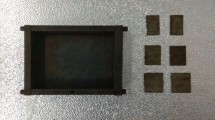Summary
There are two types of fracture patterns in the yield pillars of the potash mines of Saskatchewan. The individual members of both patterns are tensile (extension) fractures that propagate parallel with the maximum principal stress trajectory (perpendicular to the minimum principal stress). The difference between the two patterns lies in the arrangement of the member fractures. In theen echelon tensile crack-array, the macroscopic fracture consists of individual tensile cracks that are slightly offset from each other. They have only a small overlap and the child crack seems to form randomly on either side of its parent. Consequently, the en echelon tensile crack-array inherits the axial orientation of its members. In contrast, the tensile cracks of anen echelon shear crack-array, have a larger overlap and their lateral displacement from each other is biased in one direction. Therefore, the crack-array is no longer axial but inclined 20–25 degrees from the maximum principal stress direction. With increasing stress, the shear crack-array often collapses, forming theenvelope orhourglass structures of the potash mines.
Similar content being viewed by others
References
Aubertin, M., Gill, D., Ladanyi, B. (1991): A unified viscoplastic model for the inelastic flow of alkali halides. Mech. Mater. 11, 63–82.
Brace, W. F. (1964): Brittle fracture of rocks. In: Judd, W. R. (ed.), Proc., State of stress in the earth's crust, Santa Monica, California, Elsevier, Amsterdam, 111–178.
Carter, B. J. (1992a): Physical and numerical modelling of fracture in rock: with special emphasis on the potash mines of Saskatchewan. Ph.D. thesis, Civil Engineering Department, University of Manitoba.
Carter, B. J. (1992b): Size and stress gradient effects on fracture around cavities. Rock Mech. Rock Engng. 25, 167–186.
Carter, N., Hansen, F. (1983): Creep of rock salt. Tectonophysics 94, 275–333.
Duncan, E. J. S. (1990): Deformation and strenghth of Saskatchewan potash rock. Ph.D. thesis, Department of Civil Engineering, University of Manitoba.
Duncan, E. J. S., Lajtai, E. Z. (in press): The creep of potash salt rock from Saskatchewan. Geotechn. Geol. Engng. accepted for publication.
Fairhurst, C., Cook, N. G. W. (1966): The phenomenon of rock splitting parallel to free surfaces under compressive stress. In: Proc., 1st Congress Int. Society Rock Mech. Lisbon, 687–692.
Griffith, A. A. (1924): The theory of rupture. In: Proc., 1st Int. Congress Appl. Mech., Delft, 55–63.
Groves, G., Kelly, A. (1963): Independent slip systems in crystals. Phil. Mag., 8, 877–887.
Horseman, S., Passaris, E. (1984): Creep tests for storage cavity closure prediction. In: Proc., 1st Conference Mechanical Behaviour of Salt, Pennsylvania State University, Trans Tech Publ., 119–157.
Kranz, R. L. (1983): Microcracks in rocks: A review. Tectonophysics 100, 449–480.
Lajtai, E. Z., Carter, B. J., ayari, M. L. (1990): Criteria for brittle fracture in compression. Engng. Fract. Mech. 37, 59–74.
Lajtai, E. Z., Duncan, E. J. S. (1988): The mechanism of deformation and fracture in potash rock. Canadian Geotechn. J. 25, 262–278.
Peng S., Johnson, A. M. (1972): Crack growth and faulting in specimens of Chelmsford granite. Int. J. Rock Mech. Min. Sci. Geomech. Abstr. 9, 37–86.
Pollard, D. D., Segall, P., Delaney, P. T. (1982): Formation and interpretation of dilatant echelon cracks. Bull. Geol. Soc. Am. 93, 1291–1303.
Ramsay, J. G. (1967): Folding and fracturing of rocks. McGraw-Hill, New York.
Richart, F. E., Bradtzaeg, A., Brown, R. L. (1928): A study of the failure of concrete under combined compressive stresses. Bull. Univ. Illinois Engng. Res. Station 185, 3–103.
Senseny, P. E. (1984): Specimen size and stress history effects on the creep of salt. In: Proc., 1st Conference Mechanical Behaviour of Salt, Pennsylvania State University, Trans. Tech. Publ., 369–383.
Senseny, P. E., Hansen, F. D., Russel, J. E., Carter, N. L., Handin, J. W. (1992): Mechanical behaviour of rock salt: phenomenology and micromechanisms. Int. J. Rock Mech. Min. Sci. Geomech. Abstr. 29, 363–378.
Skrotzki, W. (1984): An estimate of the brittle to ductile transition in salt. In: Proc., 1st Conference Mechanical Behaviour of Salt, Pennsylvania State University, Trans. Tech. Publ., 381–388.
Skrotzki, W., Haasen, P. (1988): The role of cross slip in the steady state creep of rock salt. In: Proc., 2nd Conference Mechanical Behaviour of Salt, Hannover, Germany, Trans. Tech. Publ., 69–81.
Von Mises, R. (1928): Mechanik der plastischen Formänderung von Kristallen. Z. für Angew. Math. Mech. 8, 161–185.
Worsely, N., Fuzesy, A. (1979): The potash-bearing members of the Devonian Prairie Evaporite of southeastern Saskatchewan, south of the mining area. Economic Geol. 74, 377–388.
Author information
Authors and Affiliations
Rights and permissions
About this article
Cite this article
Lajtai, E.Z., Carter, B.J. & Duncan, E.J.S. En echelon crack-arrays in potash salt rock. Rock Mech Rock Engng 27, 89–111 (1994). https://doi.org/10.1007/BF01020207
Issue Date:
DOI: https://doi.org/10.1007/BF01020207




